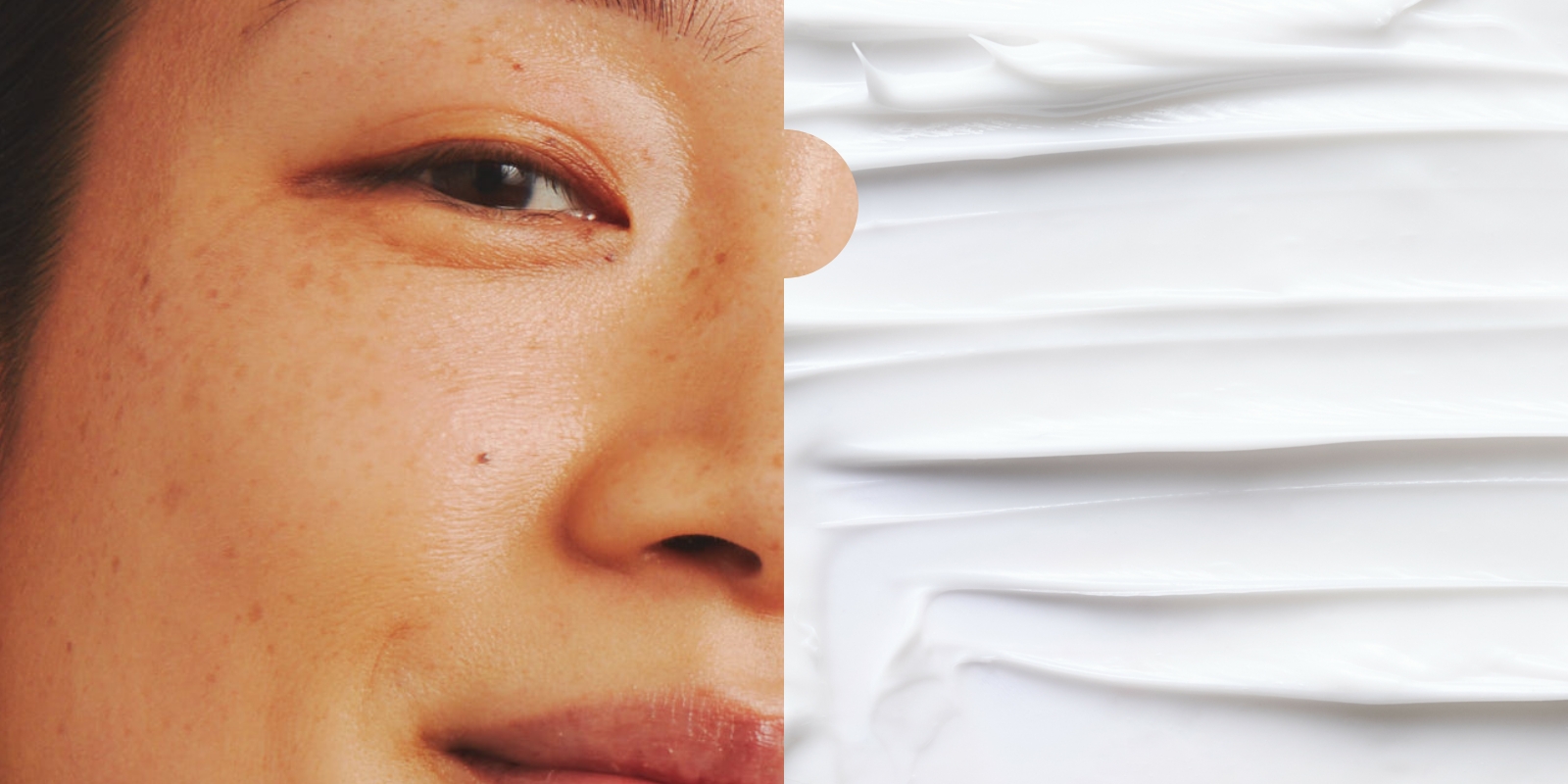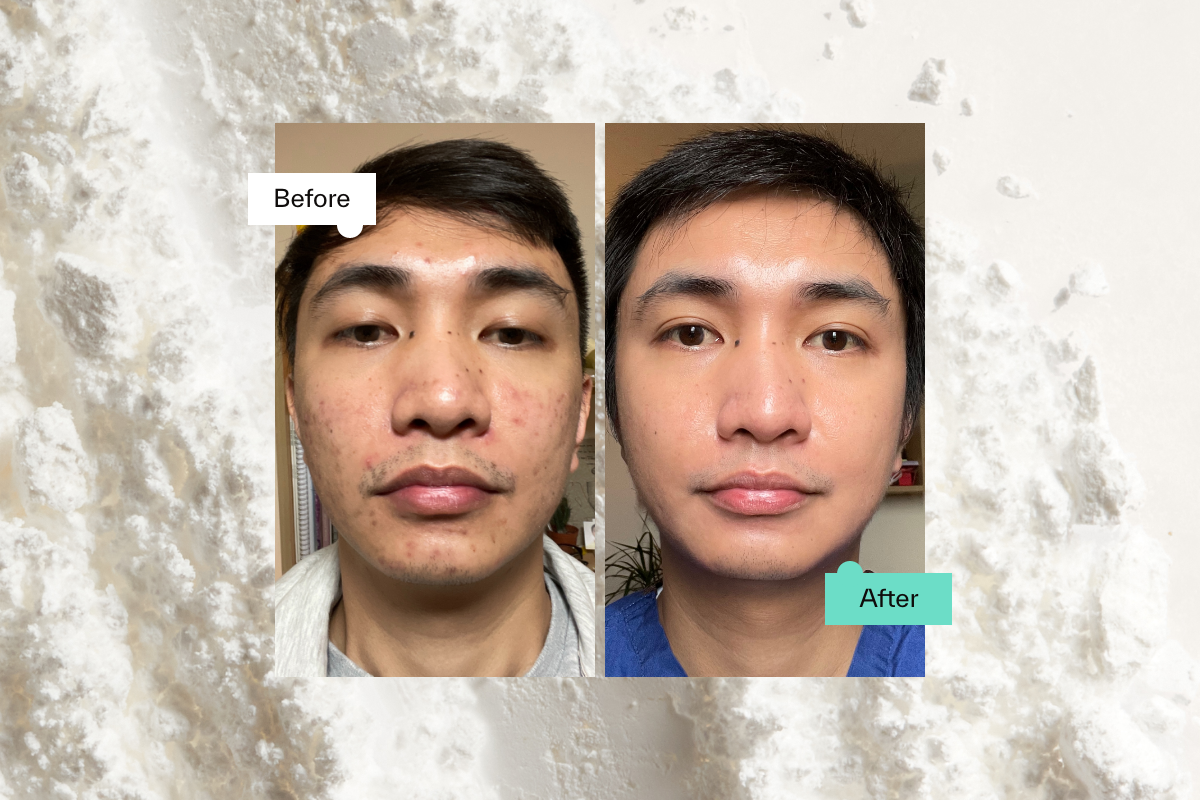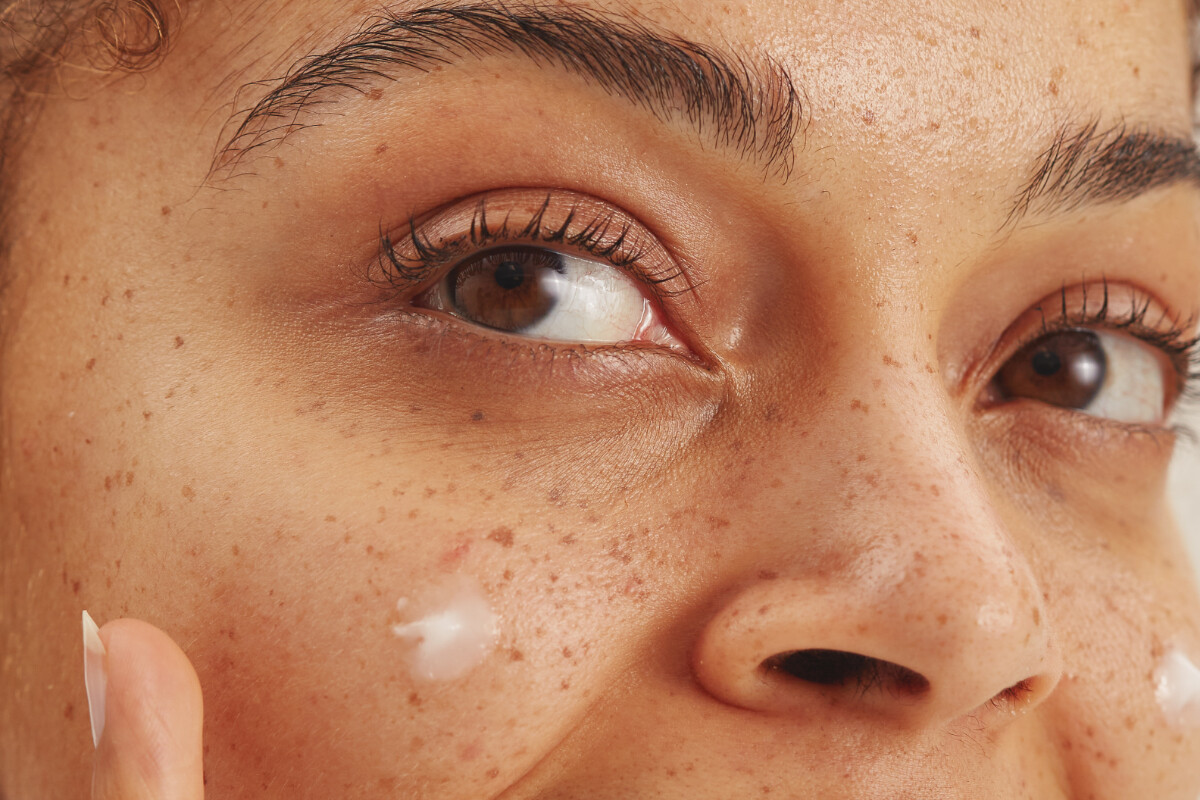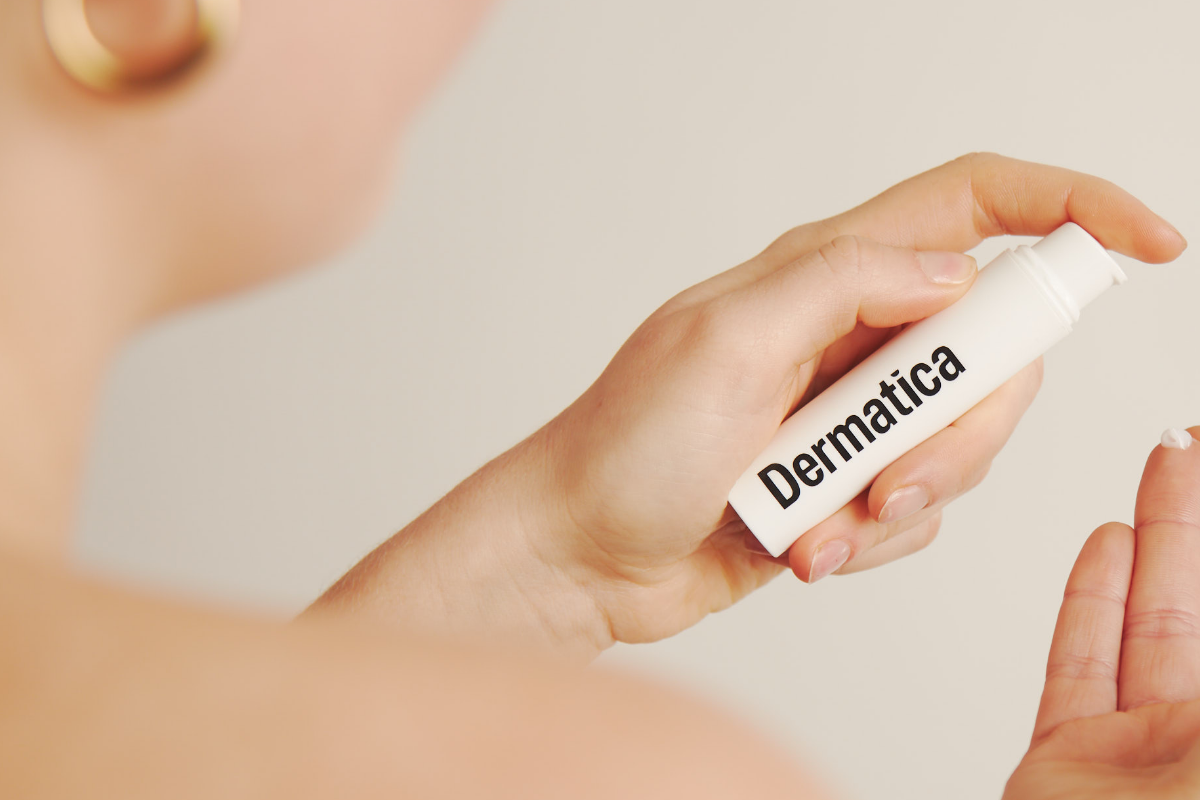If you have dark spots, melasma or hyperpigmentation, hydroquinone is a prescription-only active ingredient that could help you achieve more even-toned skin.
In this guide, we explore the potential of hydroquinone for treating all forms of hyperpigmentation, from melasma and sun damage to post-acne marks. You’ll find out how hydroquinone cream works, what licensed dermatology professionals prescribe it for, how suitable it is for long-term use, and alternatives you might consider to treat it instead.
What is Hyperpigmentation?
Hyperpigmentation is a common skin condition that causes patches of skin to become darker than the surrounding area.
This condition happens when there’s an overproduction of melanin, the pigment that gives our skin its colour. This excess melanin is harmless, but can be tricky to treat without a prescription or cosmetic procedures like laser. (1)
Causes of Hyperpigmentation
Several factors contribute to hyperpigmentation, including:
– Sun exposure: Exposure to sunlight stimulates melanin production, leading to dark spots. (2)
– Hormonal changes: Pregnancy, birth control pills, and hormonal therapies can cause melasma.
– Inflammation: Acne, eczema, and other skin conditions can result in the formation of dark spots. (3)
– Skin injuries: Cuts, burns, and even aggressive skincare treatments can cause dark spots.
Types of Hyperpigmentation
Hyperpigmented skin conditions come in different forms:
– Melasma: Characterised by brown spots or grayish patches, melasma (also known sometimes as chloasma) typically appears on the face and is triggered by sun exposure or hormonal changes. (4)
– Age spots: Also known as liver spots or sunspots, these are flat, tan, brown, or black spots caused by prolonged sun exposure. (5)
– Post-inflammatory hyperpigmentation: Dark spots that develop after skin inflammation or injury, such as acne scars.
What is Hydroquinone?
Hydroquinone is a skin-lightening agent. It’s considered a gold standard treatment option for hyperpigmentation concerns like dark spots and melasma. By inhibiting melanin production, it helps even out the complexion. (6)
How Hydroquinone Works On Hyperpigmentation
Hydroquinone can have a skin lightening effect. It does this by inhibiting tyrosinase, a crucial enzyme that’s involved in the production of melanin (the pigment responsible for the colour of our skin, hair, and eyes).
Tyrosinase converts the amino acid tyrosine into melanin. Hydroquinone interrupts this process by inhibiting tyrosinase, which reduces the production of melanin. The amount of pigment in the skin therefore decreases, resulting in a lighter complexion and less visible hyperpigmentation.
Hydroquinone is a prescription-only ingredient because using it can cause potential side effects. However, under professional guidance, hydroquinone is still a gold standard treatment for treating hyperpigmentation effectively. (7)
Hydroquinone Precautions, Adverse Effects And Possible Allergic Reactions
Hydroquinone does have the potential to cause adverse side effects, particularly skin irritation and ochronosis – a condition characterised by bluish-black dark spots on the skin. There are also rare reports of skin darkening with hydroquinone use, especially in individuals with darker skin tones. (7) In these instances, it’s important to consult your dermatologist and stop treatment.
Is Hydroquinone Suitable For Long-Term Use?
Given the potential side effects, there are concerns around how safe it is to use topical hydroquinone too much, or for too long.
To prevent these adverse effects, your dermatology provider should only recommend using hydroquinone for short periods, typically in cycles of three to four months, followed by a break. During this break, you can replace hydroquinone with other skincare ingredients, like tranexamic acid or kojic acid, to maintain your results and minimise potential side effects. Keep reading to find out more about alternative treatments. (8)
Ultimately, your decision to use hydroquinone should be made with a licensed dermatology expert, like a member of the clinical team at Dermatica . We assess your skin concerns, monitor your progress, and make sure your personalised treatment plan is safe and effective for your skin.
How Effective Is Hydroquinone?
The effectiveness of your hydroquinone treatment will depend on its concentration, formulation, and your skin type and its condition. Usually, the higher the concentration of the active ingredient (in this case hydroquinone), the more potent the treatment is. However, it’s also more likely to cause side effects. This is why it’s so important to only use hydroquinone under the guidance of a licensed dermatology professional. (9)
Alternative Treatments for Hyperpigmentation
If you’re taking a break from hydroquinone, or you’re reluctant to try it, there are many other effective treatments for hyperpigmentation conditions. Like hydroquinone, these topical (applied on the skin) ingredients also block the activity of tyrosinase.
Retinoids
Topical creams with retinoids block the enzyme tyrosinase to help fade hyperpigmentation. Periods of time to see results often vary, but most people see fewer dark spots from a personalised retinoid formula after just 6 weeks. (10)
Kojic acid
Kojic acid is derived from fungi and fermented foods. Like hydroquinone, it’s a tyrosinase inhibitor, meaning it works to reduce melanin production and it can lighten hyperpigmentation.
While hydroquinone can cause irritation or sensitivity if you use it for too long, kojic acid is generally gentler on the skin. It’s a non-prescription alternative you can use to maintain results without the risk of overexposure and potential side effects. (11)
Tranexamic acid
Studies have shown that tranexamic acid effectively reduces melanin production and hyperpigmentation.
A big advantage of tranexamic acid is that it suits a wide range of skin types, including sensitive skin. It can also be used safely over extended periods, making it an excellent option during breaks from hydroquinone.
Tranexamic acid can also complement other skincare ingredients, like Vitamin C and niacinamide, to address hyperpigmentation and promote overall skin health. (12)
Add Vitamin C 15% Fresh Batch Ascorbic Acid or Nourishing Ceramide + Peptide Moisturiser with niacinamide to your routine.
Alpha-hydroxy acids
Alpha-hydroxy acids (AHAs) like glycolic acid or lactic acid work by loosening the bonds between dead skin cells, revealing fresher, brighter skin underneath. This process can help fade dark spots and uneven skin tone over time.
AHAs can also stimulate collagen production, and improve your skin texture and overall appearance.
One advantage of AHAs is that this exfoliant suits most skin types. We advise starting on a lower strength if you have sensitive skin, then gradually increasing it, to minimise the risk of irritation. (13)
Azelaic acid
Azelaic acid doesn’t just help reduce the appearance of hyperpigmentation. It also has anti-inflammatory properties that can help calm the redness and inflammation associated with conditions like acne and rosacea. This lowers the risk of post-inflammatory hyperpigmentation. It’s also suitable for all skin types, including sensitive skin, and while pregnant or breastfeeding. (14)
Try it in our Clarifying Azelaic Acid 12% Cream.
Arbutin
Arbutin can lighten hyperpigmentation without the potential side effects associated with hydroquinone. It’s considered a safer alternative for people with sensitive skin.
It has antioxidant properties that can help protect the skin from environmental damage and premature ageing. Arbutin is also hydrating, making it suitable for individuals with dehydrated or dry skin.
While not as potent as hydroquinone, it’s an effective option. You’ll often find it formulated in skincare products with other brightening agents to enhance its efficacy. (15)
Vitamin C
Not only is Vitamin C a tyrosinase inhibitor, it also has antioxidant properties, which can help prevent oxidative stress in the skin. Oxidative stress can speed up melanogenesis, the process of melanin production. By reducing oxidative stress, Vitamin C also indirectly slows down tyrosinase activity. (16)
Prevention and Management of Hyperpigmentation
Preventing and managing hyperpigmentation involves:
– Protecting your skin from sun exposure: Wear broad-spectrum sunscreen daily, seek shade, and wear protective clothing. Applying sunscreen with SPF 30+ is crucial when using hydroquinone, as it can increase how sensitive your skin is to sun exposure.
– Proper skincare routine: Use gentle cleansers, exfoliate regularly, and incorporate brightening ingredients like Vitamin C into your skincare routine.
– Lifestyle changes: Avoid picking at your skin, manage stress levels, and maintain a healthy lifestyle. (17)
When To Seek Professional Advice
You may want to consult a dermatology professional if:
– Your hyperpigmentation is severe or persistent.
– Over-the-counter treatments aren’t working.
– You have concerns about skin changes.
Important Factors to Consider When Seeking Medical Advice
When seeking medical advice for hyperpigmentation, consider factors like:
– Treatment options and potential side effects.
– Cost and convenience of treatment.
– The clinical care you’ll receive from the dermatology team.
If you think you have hyperpigmentation – knowing the causes, types, and treatment options will help you effectively manage it.
Find out what formulas are suitable for your skin by visiting our website, alongside quick, convenient access to dermatology advice and treatment recommendations. Our clinical team are all licensed healthcare professionals who specialise in dermatology. We analyse your answers and photos to formulate a personalised treatment specifically for you.
As part of your subscription, you’ll also gain access to unlimited online consultations with real experts. We monitor your progress throughout, and answer any of your questions.
References
1) Thawabteh AM, Jibreen A, Karaman D, Thawabteh A, Karaman R. Skin Pigmentation Types, Causes and Treatment—A Review. Molecules [Internet]. 2023 Jan 1;28(12):4839. Available from: https://www.mdpi.com/1420-3049/28/12/4839
2) Desai SR. Hyperpigmentation therapy: a review. The Journal of clinical and aesthetic dermatology [Internet]. 2014 [cited 2024 Apr 17];7(8):13–7. Available from: https://www.ncbi.nlm.nih.gov/pmc/articles/PMC4142815
3) Al-Qarqaz F, Bodoor K, Baba A, Al-Yousef A, Muhaidat J, Alshiyab D. Post-Acne Hyperpigmentation: Evaluation of risk factors and the use of Artificial Neural Network as a predictive classifier. Dermatology Reports. 2021 Oct 6;
4) Espósito ACC, Cassiano DP, da Silva CN, Lima PB, Dias JAF, Hassun K, et al. Update on Melasma—Part I: Pathogenesis. Dermatology and Therapy. 2022 Jul 29;12(9):1967–88.
5) Choi W, Yin L, Smuda C, Batzer J, Hearing VJ, Kolbe L. Molecular and histological characterization of age spots. Experimental Dermatology. 2017 Feb 9;26(3):242–8.
6) Schwartz C, Jan A, Zito PM. Hydroquinone [Internet]. PubMed. Treasure Island (FL): StatPearls Publishing; 2024 [cited 2024 Apr 17]. Available from: https://www.ncbi.nlm.nih.gov/books/NBK539693
7) Fabian IM, Sinnathamby ES, Flanagan CJ, Lindberg A, Tynes B, Kelkar RA, et al. Topical Hydroquinone for Hyperpigmentation: A Narrative Review. Cureus [Internet]. 2023 Nov 15; Available from: https://www.ncbi.nlm.nih.gov/pmc/articles/PMC10723018/
8) Schwartz C, Jan A, Zito PM. Hydroquinone [Internet]. PubMed. Treasure Island (FL): StatPearls Publishing; 2020. Available from: https://www.ncbi.nlm.nih.gov/books/NBK539693/
9) Monteiro R, Kishore Bn, Bhat R, Sukumar D, Martis J, Ganesh Hk. A comparative study of the efficacy of 4% hydroquinone vs 0.75% Kojic acid cream in the treatment of facial melasma. Indian Journal of Dermatology. 2013;58(2):157
10) Callender VD, Baldwin H, Cook-Bolden FE, Alexis AF, Stein Gold L, Guenin E. Effects of Topical Retinoids on Acne and Post-inflammatory Hyperpigmentation in Patients with Skin of Color: A Clinical Review and Implications for Practice. American Journal of Clinical Dermatology. 2021 Nov 9;
11) Wawrzyk-Bochenek I, Rahnama M, Stachura M, Wilczyński S, Wawrzyk A. Evaluation of the Reduction of Skin Hyperpigmentation Changes under the Influence of a Preparation Containing Kojic Acid Using Hyperspectral Imaging—Preliminary Study. Journal of Clinical Medicine [Internet]. 2023 Apr 4;12(7):2710. Available from: https://www.ncbi.nlm.nih.gov/pmc/articles/PMC10094916/
12) Batra J, Brar B, Kumar S, Arora H. Tranexamic acid in melasma: Comparative evaluation of therapeutic efficacy of oral tranexamic acid versus its transepidermal administration. Journal of Cutaneous and Aesthetic Surgery. 2022;15(4):394.
13) Tang SC, Yang JH. Dual Effects of Alpha-Hydroxy Acids on the Skin. Molecules : A Journal of Synthetic Chemistry and Natural Product Chemistry [Internet]. 2018 Apr 10;23(4). Available from: https://www.ncbi.nlm.nih.gov/pmc/articles/PMC6017965/
14) Wardah A, Rahf A, Danah A, Moudhi S, Abdulaziz A, Alkanderi JJ, et al. Azelaic Acid Versus Hydroquinone for Managing Patients With Melasma: Systematic Review and Meta-Analysis of Randomized Controlled Trials. ProQuest [Internet]. 2023;15(7).
15) Boo YC. Arbutin as a Skin Depigmenting Agent with Antimelanogenic and Antioxidant Properties. Antioxidants [Internet]. 2021 Jul 15;10(7):1129. Available from: https://www.ncbi.nlm.nih.gov/pmc/articles/PMC8301119/
16) Sanadi RM, Deshmukh RS. The effect of Vitamin C on melanin pigmentation – A systematic review. Journal of Oral and Maxillofacial Pathology : JOMFP [Internet]. 2020;24(2):374–82. Available from: https://www.ncbi.nlm.nih.gov/pmc/articles/PMC7802860/?report=printable
17) Desai SR. Hyperpigmentation Therapy: A Review. The Journal of Clinical and Aesthetic Dermatology [Internet]. 2014 Aug 1;7(8):13. Available from: https://www.ncbi.nlm.nih.gov/pmc/articles/PMC4142815/
Ash Sharma
Dr Ashwin Sharma is a medical doctor and writer with a particular interest in health technology, artificial intelligence and medical weight loss. He completed his training at the University of Leicester and Imperial College London, and has since been exploring the intersections of medicine, technology, and communication.





